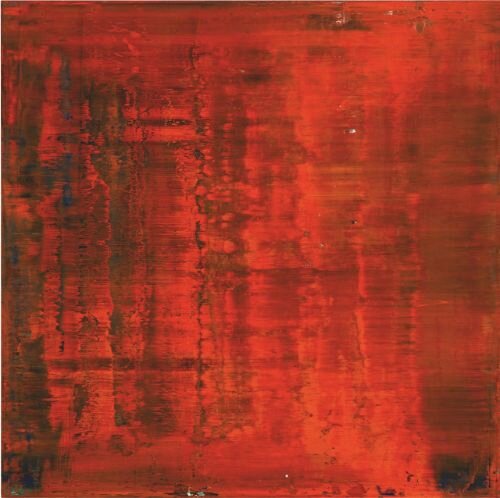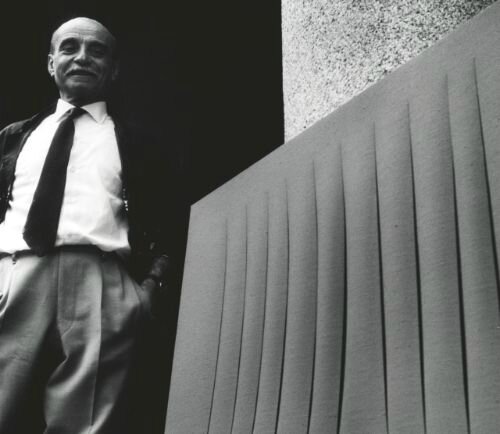Lucio Fontana '1899 - 1968), Concetto Spaziale, Attese, 1964
Lot 15. Lucio Fontana '1899 - 1968), Concetto Spaziale, Attese, signed, titled and inscribed è entrata la Lella/1+1 30/30 (o 30/38) on the reverse, waterpaint on canvas, 75 by 92cm.; 29 1/2 by 36 1/4 in. Executed in 1964. Estimate 4,000,000 — 5,000,000 GBP (5,543,986 - 6,929,983 EUR). Lot sold 4,405,000 GBP. Photo Sotheby's
PROVENANCE: McRoberts and Tunnard Gallery, London
Galerie Heseler, Munich
A. Moroni, Milan
Private Collection, Milan
Private Collection, Milan
Acquired directly from the above by the present owner in 1982
EXPOSITION: Munich, Galerie Heseler, Fontana, 1969
BIBLIOGRAPHIE: Juan Eduardo Cirlot, Lucio Fontana, Barcelona 1966, p. 41, illustrated
Enrico Crispolti, Lucio Fontana, Catalogue Raisonné des Peintures et Environments Spatiaux, Vol. II, Brussels 1974, p. 151, no. 64. T 11, illustrated
Enrico Crispolti, Lucio Fontana, Catalogo Generale, Vol. II, Milan 1986, p. 517, no. 64 T 11, illustrated
Enrico Crispolti, Lucio Fontana, Catalogo Ragionato di Sculture, Dipinti, Ambientazioni, Vol. II, Milan 2006, p. 708, no. 64 T 11, illustrated
Lucio Fontana with the present work. Image: Shunk Kender © Roy Liechtenstein Foundation Artwork: © Lucio Fontana/SIAE/DACS, London 2015
Notes: A progression of ten assured incisions across a sumptuous red canvas, Lucio Fontana’s lyrical Concetto Spaziale, Attesefrom 1964, is an incredibly rare example of the artist’s venerated series of tagli. One of only two red tagli with ten cuts recorded in Enrico Crispolti's Catalogo Ragionato, Concetto Spaziale, Attese fuses seductive chromatic power with the preoccupation at the core of Spatialism, the infinity of space. The ten rhythmic incisions dance across the opulent surface, penetrating the picture plane as they traverse across. Its chromatic brightness amplifies the profound darkness of the plunging black recesses that aptly signify Fontana’s quest for "the Infinite, the inconceivable chaos, the end of figuration, nothingness" (Lucio Fontana quoted in: Exhibition Catalogue, London, Hayward Gallery, Lucio Fontana, 1999-2000, p. 198). The inscription on the reverse announces the arrival of “Lella”, the wife of the revered art historian Franco Russoli, and stipulates Fontana’s increasing acclaim on the international art scene. Created two years before the artist’s major exhibition at the Venice Biennale XXXIII, where Fontana was awarded the first prize for his entirely white Ambienti Spaziale (Spatial Environment), Concetto Spaziale, Attese was executed at the height of the artist’s truly ground-breaking conceptual dialogue. Harry Shunk paid tribute to this extraordinary work in a series of around 17 photographs. In a beautiful coalescence of the classical with the transgressive these images depict Fontana and the work outside his studio in the courtyard of the Palazzo Cicogna, Milan. It is amongst a handful of rare masterpieces with which the artist was photographed; indeed Fontana’s choice to showcase this particular painting in this distinguished group of images is testament to the esteem with which he personally regarded it.
Gerhard Richter Abstraktes Bild, 1991. Private Collection © Gerhard Richter, 2015
The artistic theory behind the creation of Fontana’s revolutionary tagli (cuts), and before them his buchi (holes), was professed in Fontana's first manifesto, the Manifesto Blanco, published in 1946. Here Fontana proposed the concept of Spatialism, which sought to articulate the fourth dimension and sparked a unique dialogue with the ‘dimensionality’ of painting. Not only did Fontana invite three dimensions into the traditionally flat canvas ground, but his rupture of the picture plane and revelation of a blackened void beyond, implored a metaphysical dialogue with the fourth dimension and its enigmatic comingling of both time and space. A fascination with the unknowable void and concept of energy as an invisible force are summated by the mesmerising effect of Fontana’s defined slashes. As outlined by the artist: “with the slash I invited a formula that I don’t think I can perfect. I managed with this formula to give the spectator an impression of spatial calm, of cosmic rigour, of serenity in infinity” (Enrico Crispolti, Lucio Fontana, Catalogo Ragionato di Sculture, Dipinti, Ambientazioni,Vol I, Milan 2006, p. 105).
Mark Rothko, Red on Orange, 1955. The Museum of Modern Art, New York. Image: © 2015. Digital image, The Museum of Modern Art, New York/Scala, Florence Artwork: © 1998 Kate Rothko Prizel & Christopher Rothko ARS, NY and DACS, London
Contemporaneously in tune with an international political context of technological ambition and progression, Fontana’s Spatialist theories speak to the age of space exploration and discovery. In 1957 the U.S.S.R. launched Sputnik, the world’s first artificial satellite, into orbit; in 1959, the Soviets landed probe Luna 2 on the moon. The “space race” permeated political rhetoric internationally, establishing the moon as the next frontier for human exploration. Reflective of a zeal for scientific advancement, Fontana’s departure from traditional illusionism transformed the canvas into a conduit and vehicle for an intimation of an inscrutable fourth dimension. As explained by Fontana: “the discovery of the Cosmos is that of a new dimension, it is the Infinite: thus I pierce the canvas, which is the basis of all arts and I have created an infinite dimension, an x which for me is the basis for all Contemporary Art” (Lucio Fontana quoted in: Exhibition Catalogue, New York, Solomon R. Guggenheim Museum, Lucio Fontana: Venice/New York, 2006, p. 19). Nonetheless, though Fontana pioneered a dialogue that echoed advances in technology and the contemporaneous progress of space exploration – an impetus attuned to the utopian tenets of Futurism – his practice also looked back towards the most traditional remit of Western art history, namely its grounding in the Catholic Church.
Michelangelo Merisi da Caravaggio, Madonna of the Rosary, circa 1607. Kunsthistorisches Museum, Vienna. Image: © Mondadori Electa / Bridgeman Images
The lyrical black cuts incised into the deep crimson surface of the present work elicit a tenably visceral reading that is steeped in the vernacular of western art history. The ineluctable smoothness of the pulsating red pigment saturates the canvas like blood seeping from an open wound. Concetto Spaziale, Attese is thus a wounded canvas that in turn represents a Modernist echo of the wounds of Christ on the cross. Significantly, much like the art of the past in its deliverance of the message of salvation, in Fontana’s work, it is only by enacting violence upon an unblemished surface and sacrificing the possibility of representational illusion that an intimation of an unknown realm can be attained. Herein, it is his idiosyncratic gesture – the iconoclastic cut – that continues a legacy, which has shaped the development of Western art history: the Christian notion of transfiguration through violence and suffering.
Lucio Fontana with the present work. Image: Shunk Kender © Roy Liechtenstein Foundation Artwork: © Lucio Fontana/SIAE/DACS, London 2015
Marking a unique marriage of the distinctly traditional with the unequivocally progressive, Concetto Spaziale, Attesecoalesces past, present and future within the slender abyss of each cut. An assured articulation of Fontana’s revolutionary desire to further the very boundaries of our phenomenological perception, it embodies the artist's pioneering spatial theories, whilst engendering a unique dialogue between the symbolic power of colour and form.
Sotheby's. Contemporary Art Evening Auction, 01 july 2015, London

/https%3A%2F%2Fprofilepics.canalblog.com%2Fprofilepics%2F1%2F0%2F100183.jpg)
/https%3A%2F%2Fstorage.canalblog.com%2F03%2F02%2F119589%2F96711876_o.jpg)
/https%3A%2F%2Fstorage.canalblog.com%2F11%2F31%2F119589%2F94773502_o.jpg)
/https%3A%2F%2Fstorage.canalblog.com%2F20%2F83%2F119589%2F94772815_o.jpg)
/https%3A%2F%2Fstorage.canalblog.com%2F26%2F72%2F119589%2F75604929_o.jpg)
/https%3A%2F%2Fstorage.canalblog.com%2F59%2F60%2F119589%2F26458628_o.jpg)









/image%2F1371349%2F20240313%2Fob_3da818_431115881-1632814154155264-57534444325.jpg)
/image%2F1371349%2F20240312%2Fob_cc9c83_f2.jpg)
/image%2F1371349%2F20240311%2Fob_2edda2_fontana.jpg)
/http%3A%2F%2Fstorage.canalblog.com%2F86%2F67%2F119589%2F129815803_o.png)